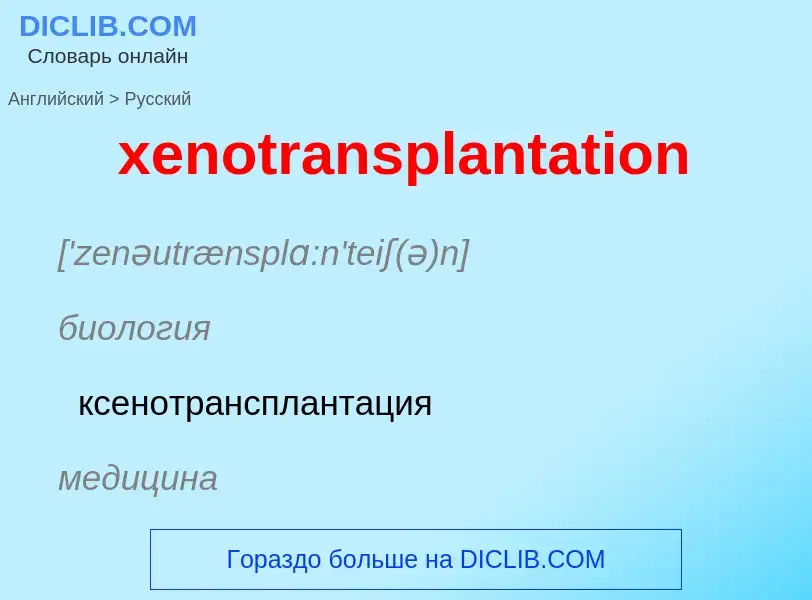Tradução e análise de palavras por inteligência artificial ChatGPT
Nesta página você pode obter uma análise detalhada de uma palavra ou frase, produzida usando a melhor tecnologia de inteligência artificial até o momento:
- como a palavra é usada
- frequência de uso
- é usado com mais frequência na fala oral ou escrita
- opções de tradução de palavras
- exemplos de uso (várias frases com tradução)
- etimologia
xenotransplantation - tradução para russo
['zenəutrænsplɑ:n'teiʃ(ə)n]
биология
ксенотрансплантация
медицина
ксенопластика
прилагательное
биология
ксенотрансплантация
медицина
ксенотрансплантат
['zenə(u)grɑ:ft]
общая лексика
ксенотрансплантат
биология
ксенотрансплантат (ткань или орган, пересаживаемые от организма другого вида)
медицина
гетеротрансплантат
существительное
биология
ксенотрансплантат (ткань или орган, пересаживаемые от организма другого вида)
Definição
Wikipédia
Xenotransplantation (xenos- from the Greek meaning "foreign" or strange), or heterologous transplant, is the transplantation of living cells, tissues or organs from one species to another. Such cells, tissues or organs are called xenografts or xenotransplants. It is contrasted with allotransplantation (from other individual of same species), syngeneic transplantation or isotransplantation (grafts transplanted between two genetically identical individuals of the same species) and autotransplantation (from one part of the body to another in the same person). Xenotransplantation is an artificial method of creating an animal-human chimera, that is, a human with a subset of animal cells. In contrast, an individual where each cell contains genetic material from a human and an animal is called a human–animal hybrid.
Patient derived xenografts are created by xenotransplantation of human tumor cells into immunocompromised mice, and is a research technique frequently used in pre-clinical oncology research.
Human xenotransplantation offers a potential treatment for end-stage organ failure, a significant health problem in parts of the industrialized world. It also raises many novel medical, legal and ethical issues. A continuing concern is that many animals, such as pigs, have a shorter lifespan than humans, meaning that their tissues age at a quicker rate. (Pigs have a maximum life span of about 27 years.) Disease transmission (xenozoonosis) and permanent alteration to the genetic code of animals are also causes for concern. Similarly to objections to animal testing, animal rights activists have also objected to xenotransplantation on ethical grounds. A few temporarily successful cases of xenotransplantation are published.
It is common for patients and physicians to use the term "allograft" imprecisely to refer to either allograft (human-to-human) or xenograft (animal-to-human), but it is helpful scientifically (for those searching or reading the scientific literature) to maintain the more precise distinction in usage.
Bioprosthetic artificial heart valves are generally pig or bovine-derived, but the cells are killed by glutaraldehyde treatment before insertion, therefore technically not fulfilling the WHO definition of xenotransplantation of being live cells.

